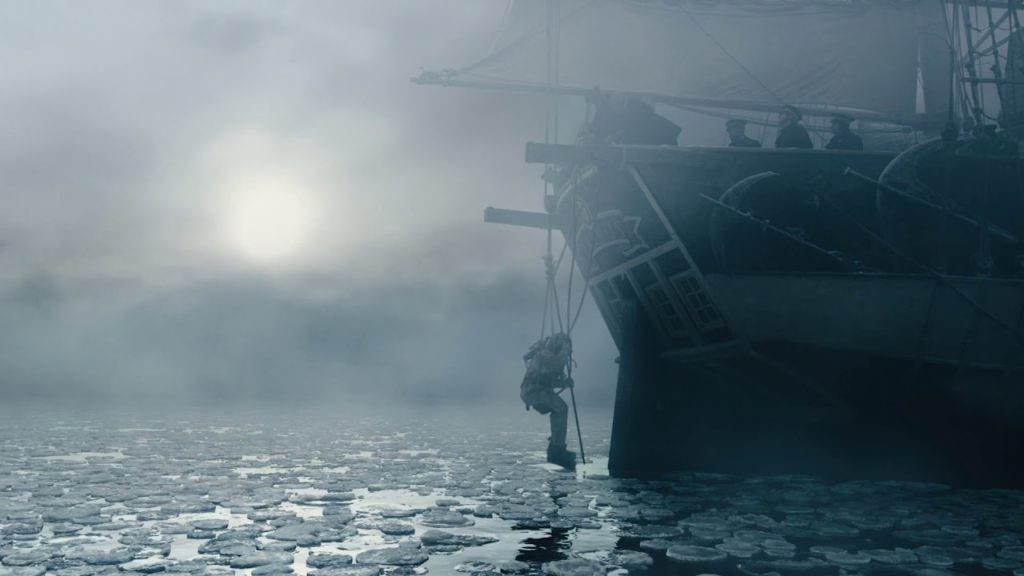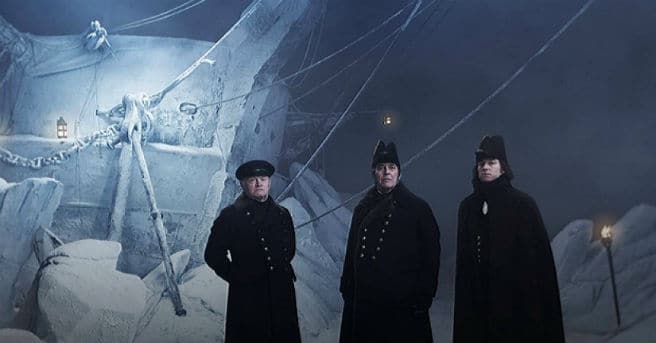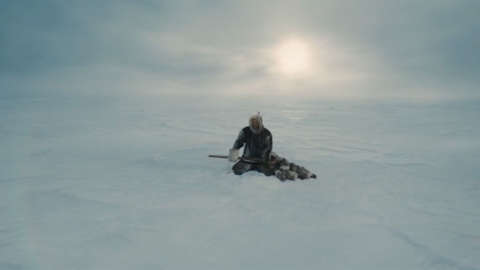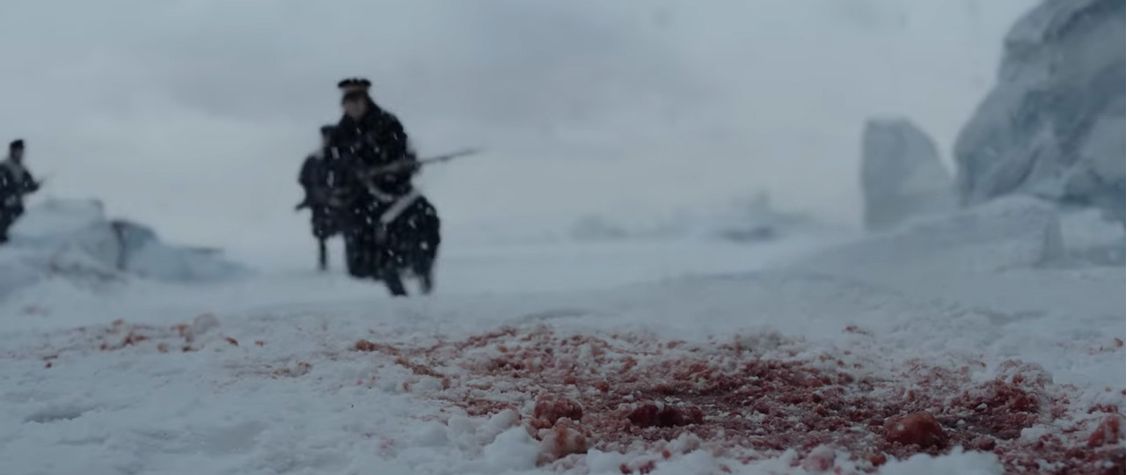Please note: this article discusses key plot points from The Terror and as such contains spoilers. Please don’t read this unless you have already seen the series.

It’s been noted elsewhere that we seem to have developed a taste for isolation horror over the past year or so. Sure, it’s always been a key factor in a lot of horrifying TV and cinema, but you can’t help but notice the sheer relish with which we’ve taken to it since we began dealing with the fallout of the Covid-19 virus, and maybe trying out a little isolation of our own – possibly for the first time. This may go some way towards explaining why The Terror, a ten-part series which was actually made back by AMC in 2018, has finally aired on BBC this year, to great acclaim. Yet there’s far more to it than that: its basis on a horrendous real-life naval mission, augmented by a layer of supernatural content which adds still more to its ‘stranger in a strange land’ story, has been a masterclass in slow-burn, measured tale-telling. Its ten-episode structure was quite possibly a hard sell at first, but it works undeniably well. It allows a large number of characters to grow and develop, it allows the interplay between the men to become suitably complex and emotional, and it means that moments of extreme violence are be rationed very carefully, never replacing the drip-drip-drip of paranoia and certainly never turning The Terror into a high-action affair. This is instead a story of (largely) good people coming apart at the seams, in one of the most hostile environments on earth.
‘Man proposes, God disposes’
The journey from the real-life expedition to the series is an interesting one, coming to us via a 2007 novel by author Dan Simmons. Given that the crewmen of both ships, HMS Terror and HMS Erebus, were lost in around the year 1848, there exist no accurate first-hand descriptions of what happened: the final destination of both crews has instead been handed down piecemeal, reliant on a few statements given by neighbouring Inuit who confirmed that they did see some of the men, but were unable at that stage to really help, and by evidence gathered on subsequent exploratory missions. Simmons saw an opportunity to explore the fate of the Terror and the Erebus imaginatively, wondering what could have befallen them in the long years until it was confirmed that there were no survivors. From this, we get the screenplay, which itself alters some elements of the novel; like any good piece of folklore, it is now difficult to separate fact from fiction. Indeed, from the point of the ships’ loss speculation was rife, with the awful truth only much later getting extrapolated – the evidence of confusion, panic, illness, hypothermia, lead poisoning, even cannibalism. None of these men had quick, quiet deaths. Why were they there, in this place, for year upon year – slowly running out of hope, despite being well-provisioned and prepared? The purpose of the mission was to navigate the as-yet rumoured Northwest Passage, which would have provided a convenient trading route, a boon to British interests and reputation and a point in history when this was of rank importance. Problem was, the winter which set in during the early part of the voyage froze the ships solidly in place – and a thaw did not come. Hundreds upon hundreds of miles away from any help, the expedition floundered, failed, and ultimately led to the deaths of its crews. It’s an appalling waste and a tragedy.
“Not a man. Not a bear. Then what?”
This would, in itself, be sufficient for a gripping series; this environment is so alien, so barren to all but those native people who have spent millennia equipping themselves with the skills to survive, that any examination of this kind of microcosm would, with a cast like the one in the series, be worthwhile. Similarly to a late Victorian novel which begins with an expedition to find the North Pole before its own shift into supernatural content (The Purple Cloud), the descriptions of the voyage itself, and the interpersonal hell of confinement in the ice, is quite horror enough. Why, then, did Simmons and then The Terror’s screenwriters decide to add in the plot detail of the Tuunbaq, the demonic bear-like creature which begins to stalk the men?
It seems to resemble folklore of similar creatures described by indigenous populations, perhaps most notably the Wendigo, another malevolent entity known to Inuit people (and other First Nation peoples): the creature, often supposed to be in a hinterland between ravenous and starving, could consume people, or induce people to consume one another; psychiatry has co-opted this mythology as Wendigo Psychosis, the desire to cannibalise. It’s a possible parallel. The Tuunbaq itself is a creation of Simmons, but its presence in the novel/series emphasises the outsider horror by throwing the already-desperate men into a situation where they are ignorant of the rules, the specific dangers attached to this being. The Tuunbaq ‘belongs’ to an Inuit man, travelling with his daughter; when some of the men accidentally shoot and kill him, the being is then detached and rogue. For the crews of Terror and Erebus, it’s something of an Ancient Mariner moment, precipitating supernatural upon natural disasters.
The men’s increasing dread about being trapped in the ice is now compounded by a vengeful, seemingly unstoppable force – a polar bear, but not a polar bear, as it seems to have humanoid features. It’s an inventive piece of creature design, and the Tuunbaq’s association with a folklore which is closed off to the outsiders places them in an impossible situation. Any hope of truly coming to know the ropes is extinguished by the Inuit woman, now bereaved, needing to take her father’s place as responsible for the Tuunbaq; to symbolise this, she cuts the tongue from her mouth. There’ll be no easy exposition here, then. And, in the meantime, the creature, craving violence rather than food as such, picks its way through the crew. Pardon me another parallel, but there’s a touch of Game of Thrones in the way that The Terror has no compunction about killing off its highest-profile characters, and doing it early. And, graphically.
“An adventure of a lifetime…”
The careful, and shifting relationships between the men is a definite highlight of the series and affords another of The Terror’s positive qualities: by selecting a good cast and allowing their characters to really develop across ten episodes, there’s no sense here that these men – either their namesakes or their fictional versions – are in any way simply bad, or stupid men, or that they’re being punished in a straightforward way for being where they shouldn’t be. You would have to be incredibly heartless to see the plight of these men and boys and feel anything but horror and pity. Yet, this could have been written that way; it could have been a very one-dimensional critique of Empire-building and the people employed in it. This is addressed, sure, but it’s done in a very subtle way which allows the audience to think, rather than being told how to think. Of course, the pursuit of the Northwest Passage was – regardless of the clout and the preparation of the British Navy – disastrous, a decision which had not a little ambition and vanity behind it, ideals which have a tendency to turn out to be vivid, but rather brittle motivators.

Then, the commercial benefits of finding passage perhaps obscured acknowledgement of the risks, particularly hitherto-unpredictable ones. The crewmen, with to some extent the exception of the higher-ranking officers, had little idea what they were getting into, and the greater glory of the British Empire was probably a far lesser impetus for joining the expeditions than more personal reasons, right down to a need for employment and board. Even amongst the higher-ranking officers, it’s clear that there’s little consensus on values and ideals, with Captain Crozier (Jared Harris) on the receiving end of anti-Irish bigotry, both before putting sail and upon arrival. There are crew members who only want to do the right thing, in particular the tragic figure of Dr. Goodsir (Paul Ready), who defends Lady Silence, the Inuit woman (Nive Nielsen) and seeks to learn her culture. His final self-sacrifice is almost saint-like. For every upright assertion over the new, uncharted territory, and to counterbalance moments like the accidental killing of Lady Silence’s father, there’s a moment of sensitivity and vulnerability. Cornelius Hickey’s (or should that be ‘Cornelius Hickey’s’) attempts to claim men and terrain for himself underline the absurdity of attempting any such thing out there, and the desperation of the situation overall – with kudos to Adam Nagaitis for navigating his way from likeable and resourceful to ambiguous to villainous. His journey from unassuming to maniacal perhaps represents the worst of the impulse to conquer, but he by no means represents all of the men, and his comeuppance is a grim, oddly poetic sequence.
For the others, sadly, there is no spectacular ending, and it’s in keeping with the series as a whole that so much of the worst of the misery takes place off-screen. Just as with their historical counterparts, we simply don’t know what their death agonies were like, and somehow allowing that space for imagination makes it all worse. The final episode – with its momentary hallucinations of groaning tables and the beautiful brightness of the natural world – are amongst the series’ most touching moments, a fantasy which reiterates what these men have come to lack. The Terror almost – almost – allows a moment of hope at the end, but the damage done to Crozier has rendered him unable and unwilling to go back to the world he’s known. He lost all of his men – this is an immense, crippling stigma for a ship’s captain – and although Inuit kindness allows him to join their small community, the final shot which lingers on him shows his torment. He has survived, but the cost is great, and he certainly doesn’t miss out on his one opportunity to be saved out of some kind of renegade spirit. “Tell them,” he instructs his Inuit neighbour about to speak to the rescue team, “that we are dead. Gone.” The Terror is a remarkable piece of television.

